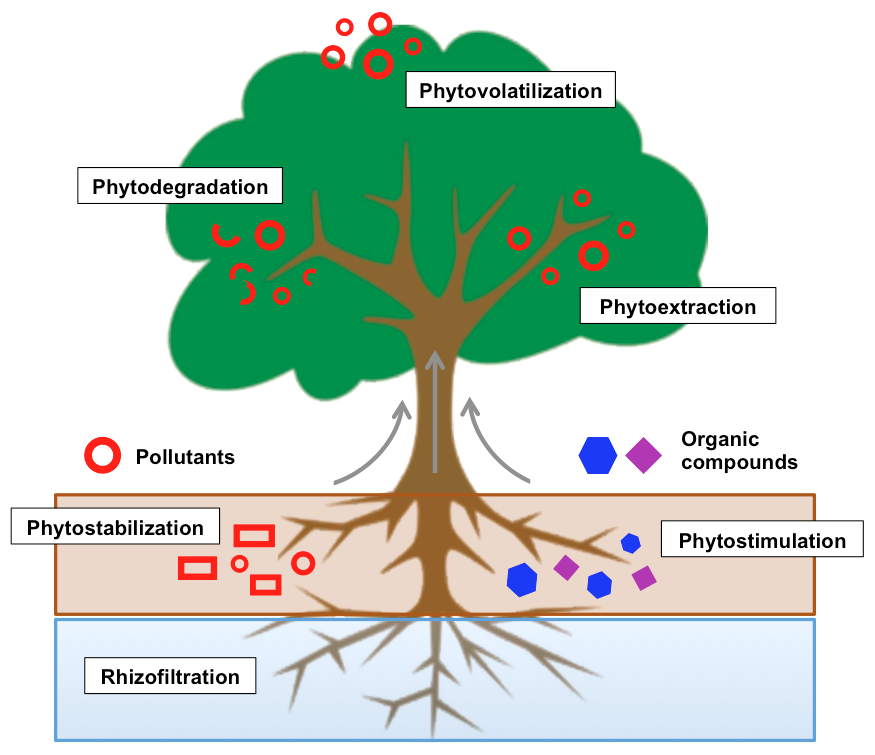Chhan Kumar Kalita
P.G. 2nd Semester, Department of Botany
Nowgong College (Autonomous), Nagaon, Assam
- Introduction:
Just as our body needs a balanced diet to stay healthy, the environment also needs a balanced amount of substances. If a substance is present in more than its threshold ratio or an unfavorable substance gets added, it pollutes the surrounding environment. Due to lack of vision and carelessness attitude of human beings, the areas of land, surface waters and ground water are affected by contamination from industrial, agricultural, household activities, which has become a serious dilemma of the hour. In these days, although various methods have put on track to the treatment of the contaminating agents, most of these mechanisms or methods are too sophisticated and expensive to operate practically.
Taking into consideration all these facts, the use of ‘Phytoremediation’ techniques for treatment of contaminants could be a feasible alternative.
- What is ‘Phytoremediation’?
In Greek, the word ‘Phyto’ means ‘plant’ and in Latin the word ‘remedium’ means ‘to restore’. Phytoremediation can be defined as “the efficient use of plants to remove, detoxify or immobilize the environmental contaminants in a growth matrix (soil, water or sediments) through the natural biological activities and plant processes”. This process can be used to clean up the contaminants, i.e. metals, pesticides, crude oil, poly-aromatic hydrocarbons etc. from a particular body.
- Pathways of ‘Phytoremediation’:
There are some specific techniques or pathways associated with ‘Phytoremediation’. These are –
- Phyto-stimulation: This process is also called rhizosphere degradation. In this process, the soil microbial activity for the degradation of organic contaminants gets enhanced in the rhizosphere region.
- Phyto-volatilization: In this process, plants absorb the organic contaminants with water and release them into air through their leaves.
- Phyto-degradation: In this process, plants use their tissues to metabolize and destroy the contaminants.
- Phyto-stabilization: In this process, chemical compounds that are produced by the plant immobilize contaminants, rather than degrade them.
- Rhizofiltration: In this process, the plant roots are used to absorb, concentrate and precipitate contaminants from groundwater.

Fig: Phytoremediation Pathways.
[Source: File:Phytoremediation Process.png – Wikimedia Commons]
A number of plant species have been found to effectively remove toxic metals such as Cu2+, Cd2+, Cr2+, Ni2+, Pb2+, Zn2+ from aqueous solutions.
- Plants used in ‘Phytoremediation’:
Some of the examples of plants used in phytoremediation practices are the following:
| No. | Vern name | Scientific name |
| 1 | Water hyacinths | Eichornia crassipes |
| 2 | Alfalfa | Medicago sativa |
| 3 | Kentucky bluegrass | Poapratensis |
| 4 | Coontail | Ceratophyllum demersum |
| 5 | American Ponweed | Potamogeton nodosus |
| 6 | Common arrow-head | Sagittaria latifolia |
| 7 | Rye Grass | Lolium perennee |
| 8 | Bermuda Grass | Cynodon dactylon |
| 9 | Carrot | Daucus carota |
| 10 | Sunflower | Helianthus annuus |
- Why Phytoremediation should be opted?
Phytoremediation could be a more suitable and applicable technique for the treatment of various types of contaminants. First of all, because of its lower operation and maintenance cost other than that of traditional processes both in situ and ex situ, it is easily affordable to anyone. Secondly, there are possibilities of recovery and reuse of valuable metals. Thirdly, it is a relatively least harmful and environment-friendly method because of the use of naturally occurring organisms in the entire operation. Fourthly, it increases soil health, yield and plant photochemicals. Last but not the least, plants can be grown without much effort and also can also be monitored easily.
- Conclusion:
Rapid industrialization has caused a financial prosperity. Simultaneously, it has created a curse affect to the environment. The environment is becoming increasingly more polluted; particularly the industrial air and water pollutants have grown as a prime hazard to the very existence of the living organisms in an aquatic environment.
As mentioned above, phytoremediation can be considered as a complementary technology that can be used in lieu of mechanical conventional clean up technologies that often demand high capital inputs and are labour-intensive plus energy-requiring.
- REFERENCES:
Vasavi, A.; Usha, R. and Swamy, P.M. (2010). Phytoremediation- An overview review. Journal of Industrial Pollution Control. 26. 83-88.
Cunningham, S.D. and Ow, D.W. (1996). Promises and prospects of phytoremediation. Plant Physiology. 110:715-719.




